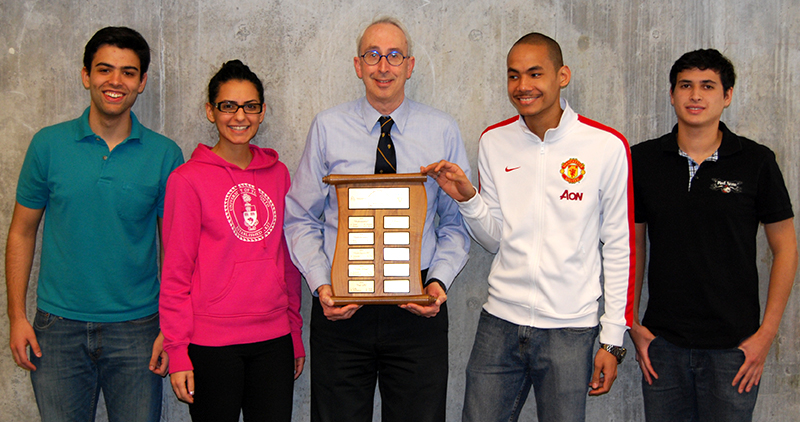May 26, 2014

It was the Dragon’s Den of engineering. What had they gotten themselves into?
This winter, four University of Toronto engineering students put their heads together and designed a new green machine: a hydrogen-powered, zero-emissions soybean harvester. A brilliant innovation, unlike anything on the market. But researching and designing the potentially world-changing combine was just the beginning—the group now had to sell a team of judges on its business viability, safety and practicality.
Shahed Mirmohammadi (ECE 1T4+PEY), Jonathan Hoo (MSE 1T0, MEng 1T6), Renan Gomes (Science Without Borders – Brazil) and Ricardo Barnasky (SWB – Brazil) each signed up for MSE558, a unique semester-long class that unites undergraduate and graduate students from all engineering disciplines in an intensive design contest. But the course demands much more than just design savvy, taking students outside their comfort zones of engineering problem-solving and adding business skills such as market analysis, branding and education.
Now in its tenth year, the course taught by MSE Professor Steve Thorpe is modeled after the National Hydrogen Association Design Contest and puts students through the whirlwind experience of launching a young start-up.
The sheer scope of the challenge and the chance to apply new nanomaterials to a real product appealed to Renan Gomes, a Brazilian exchange student studying at U of T until December 2014. “Nano is never easy—it’s always complicated, but that’s the future,” said Gomes. “Our job as engineers is to learn how to solve problems using these new technologies.”
All four shared excitement about the vision of greener farming with international impact, and their first task was to define their corporate identity. They dubbed their new company PURE, for Powerful, Unique, Reliable and Efficient. Each took an executive-style role within the team: Mirmohammadi was team leader and responsible for economic and marketing analysis, Hoo was technical lead, Gomes was responsible for safety and education, and Barnasky took the lead on environmental analysis.
As technical lead, Hoo conducted extensive research into load profiles of the current state-of-the-art, including phoning competitors, who wanted to sell him a combine, and Ontario’s Ministry of Agriculture & Food. Gomes even phoned the Brazilian government to inquire about a similar project there. “Was it like detective work? No, it was like espionage,” said Hoo. “The harvester, you don’t just drive it—you have to cut the crops and process them and store them in a tank and empty them, our load profile was pretty complex.”
The resulting design, called Zero-Emission Combine Harvester, or ZECH, is a totally green farm machine for harvesting soybeans. Hydrogen fuel cells and a solar panel run three electric motors, and three lithium-ion batteries store enough energy to power its driving, threshing, storage, emptying and cleaning phases.
“I learned so much about hydrogen fuelling, fuel cells, hydrogen storage and the issues with it, the cost of actually doing something like this—it’s doable, but it’s very expensive at this time,” added Mirmohammadi.
Team PURE united their portfolios and polished their work to a high shine in preparation for pitching their idea to the judging panel in the 18 minutes allotted. For Barnasky and Gomes, it was the first professional presentation they had ever delivered in English. “These people are sharp, they know their stuff—if you screw up, they’re going to pick up on it,” said Hoo. “This is environmental, this is technically correct, this is financially feasible, you’re going to make money—all of these things in 18 minutes,” said Mirmohammadi.
After handling a 20-minute question period with the judges, Professor Thorpe, Amy Jiang of BP and Alex Ayers of Pratt & Whitney, Team PURE emerged victorious, winning an engraved plaque and $180 in prize money. “We definitely jumped for joy,” said Mirohammadi. “It was worth it, for sure.”
The second-place team designed a food truck serving First Nations cuisine to Bay Street bankers without using an atom of fossil fuels while the third-place team invented a zero-emissions personal-delivery drone.
“The whole point of this is to come up with a holistic solution,” said Professor Thorpe. “We teach tools for screening new ideas quickly and performing failure analysis…keeping them in the box is challenging!”
“It’s the fact that it’s an actual project—if you were in a firm and you had all these different departments you work with, you can’t ever come up with one option thinking it’s technically feasible, let’s do it! Well, did you take into consideration that this is going to kill 100,000 fish? Or you’re going to have to spend billions of dollars trying to get the infrastructure to even build this thing. That’s definitely something that we’ve never done before,” said Mirmohammadi.
Despite the trial, would they enter this Dragon’s Den again?
Absolutely.
More information:
Marit Mitchell
Senior Communications Officer
The Edward S. Rogers Sr. Department of Electrical & Computer Engineering
416-978-7997; marit.mitchell@utoronto.ca